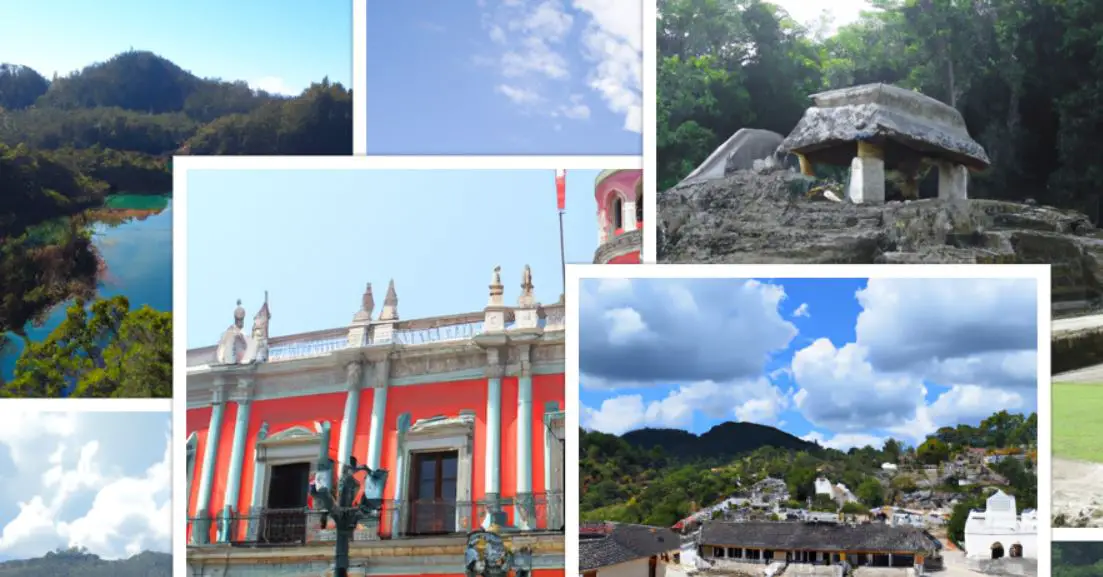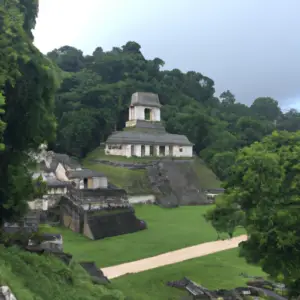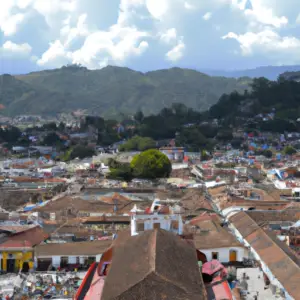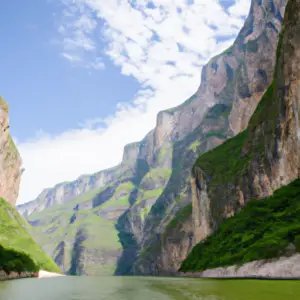10 Best Famous Monument in Chiapas | Historical Building in Chiapas

- By
- Aparna Patel
- |
- 15 May, 2023
- |

Chiapas is a Mexican state that is well known for its diversity in culture and landscape. From the ancient Mayan ruins to the stunning colonial architecture, Chiapas offers many memorable landmarks and monuments.
In this post we’ll be taking a look at the famous monuments and historical buildings in Chiapas. From ancient Mayan ruins to baroque churches, read on to discover Chiapas’ top attractions!
10 Famous Monuments and Historical Buildings To Visit In Chiapas
1. Palenque Archaeological Site
Palenque Archaeological Site is an ancient city located near the Usumacinta River in the Mexican state of Chiapas. The city was one of the most important cities of the Classic period of Mesoamerican civilization and was home to one of the largest Mayan cities during this time.
It is most famous for its incredible temple and palace complexes, ornate stelae, and intricate stone reliefs, which were all built during the 5th and 6th centuries A.D. The city also has an impressive zoo, museum and botanical garden. Today, the site is a popular tourist destination, visited by thousands of visitors each year. The ruins and their surroundings are protected by UNESCO as a World Heritage Site.
2. Zinacantan Community Museum
The Zinacantan Community Museum in Chiapas, Mexico is an open-air museum located in the town of Zinacantan. The museum is dedicated to preserving the culture, traditions and history of the Zinacantan people, a Mayan group native to the region.
The museum exhibits a variety of artifacts, including traditional clothing, baskets, musical instruments, agricultural implements, musical instruments and religious implements.
There are also multimedia displays, as well as information about the language, history and religious beliefs of the Zinacantan people. The museum is part of a wider program to promote and safeguard the cultural heritage of the area, and is open to visitors year round.
3. Aqua Azul Waterfalls
Aqua Azul Waterfalls is one of the most popular attractions of Chiapas, Mexico. Located in the foothills of the Sierra Madre de Chiapas Mountains, the Aqua Azul Waterfalls are a unique natural wonder and a great way to experience the beauty of Mexico.
The Aqua Azul Waterfalls are composed of five cascading waterfalls that are illuminated by several natural blue pools and other water features. The waterfalls are surrounded by lush rainforest and steep hills, creating a magical setting.
Visitors to the waterfalls can explore the area by hiking, swimming, and tubing in and around the waterfalls. There are also a number of restaurants and cabins near the area for those who want to stay and take in the scenery for a few days.
The Aqua Azul Waterfalls are a popular destination for tourists and locals alike, and are a great way to experience the beauty of Chiapas.
4. Montebello Lakes National Park, Mexico
Montebello Lakes National Park is located in the Mexican state of Chiapas, on the border with Guatemala. It was created in 1959 and covers an area of 335 square kilometers (209 sq mi). The park is composed of a large group of crater lakes, more than 50 volcanic cones, and associated lagoons, streams, rivers, and natural vegetation. The park is home to a variety of birds, animals, reptiles, and plant species. The climate of the region is warm, with an average annual temperature of 24°C (75°F). The rainy season is from May to October, with an average rainfall of 1200 mm.
The park is a popular tourist destination, with activities such as hiking, sightseeing, fishing, bird watching, and camping. There are many recreation areas and camping sites within the park, as well as a range of facilities for visitors, such as restrooms, picnic areas, and rental cabins. The main access point to the park is the main entrance, located at the town of El Triunfo. Other access points include the towns of 7 Lagos, San Ignacio and Anguiatu.
The park is managed by the Mexican National Commission on Protected Natural Areas (CONANP). The mission of CONANP is to promote, conserve, and restore the biodiversity and ecology of protected lands such as Montebello Lakes National Park.
Montebello Lakes National Park is an important destination for nature lovers and outdoor enthusiasts, offering a unique and diverse range of landscapes, wildlife, and atmospheres. With its enchanting lagoons and plentiful recreational activities, the park is a great place to visit in order to explore the beautiful and diverse natural features of Chiapas.
5. La Encrucijada Biosphere Reserve,Mexico
La Encrucijada Biosphere Reserve is located in the state of Chiapas, Mexico. It is a diverse natural area comprised of coastal and marine ecosystems, which include mangrove forests, wetlands and barrier islands, coral reefs, sandy beaches and sea grass beds, dry and tropical forests, swamps and river valleys.
The Biosphere Reserve acts as home to a wide range of flora and fauna, including a variety of transient and resident animal species, as well as several species of endangered and threatened marine turtles. The reserve also serves as a buffer zone for the Palenque and Agua Azul national parks and UNESCO World Heritage sites located in the area. La Encrucijada Biosphere Reserve, recognized by UNESCO in 2001, works to promote sustainable development and conservation of the region’s unique ecosystems.
6. San Cristóbal de las Casas Historic Center
San Cristóbal de las Casas Historic Center is located in the city of San Cristóbal de las Casas in Chiapas, Mexico. It is located in the ancient Maya settlement of Tolonocán. The area is known for its colonial-era architecture and cobblestone streets, which were declared a UNESCO World Heritage Site in 1987.
The San Cristóbal de las Casas Historic Center is home to a variety of notable attractions, including the San Cristóbal Cathedral, the Convent of San Domingo, and the Santo Domingo Cultural Center, among others. Visitors can also explore the numerous traditional markets, boutiques, and galleries that pepper the quaint main squares. Places to visit in the area include the Santo Domingo Cultural Center, Santo Domingo Church, Central Plaza, La Merced Church, and Santo Domingo Monastery.
Additionally, the area is known for its vibrant and unique art scene, which is characterized by a mix of traditional and more modern takes on local art and culture. A variety of festivals and events also take place in and around the San Cristóbal de las Casas Historic Center, including the Guelaguetza Festival, which is held every year in late July and serves as a celebration of the local traditions and culture.
The San Cristóbal de las Casas Historic Center is one of the most famous historical sites in Mexico and is a great place to explore the local culture and get a glimpse into the past. With its picturesque cobblestone streets and colonial-era architecture, it’s easy to see why people come from all over the world to explore this unique destination.
7. Yaxchilán Archaeological Site
Yaxchilán is an ancient Maya archaeological site located in the Mexican state of Chiapas, along the Usumacinta River. The site was first occupied in the Late Classic period, around the 6th century AD, and the major period of occupation spanned from the 6th century to the 9th century AD. Testing indicates that earlier occupation may have occurred as early as the 4th century BC.
Yaxchilán is noted for its large, intricately carved stone structures, including lintels, altars, and several palace complexes, most famously the palace of King Shield Jaguar I. The site contains a number of inscriptions describing the dynastic history of the ruling family and their various conquests and alliances with other cities.
The site is notable for the artistic style of the reliefs and lintels, which are considered to be some of the finest examples of Maya art. The decorations feature a combination of abstract motifs, anthropomorphic figures, and hieroglyphic texts.
Visitors to Yaxchilán can explore the ruins of the various structures, or take a guided tour of the site. There are also tours available to explore the area around the site, including a boat tour of the Usumacinta River. The site is a popular destination for eco-tourists and archaeologists alike, and is widely considered to be one of the most important Maya sites in Mexico.
8. Sumidero Canyon
Sumidero Canyon is located near the city of Chiapas in Mexico. It is one of the most dramatic scenery sites in the world and it is a popular tourist destination. The canyon is more than 1,000 feet deep and it is surrounded by mountains and cliffs, with waterfall-like features.
The depth of the canyon is what draws visitors. There is a great diversity of animal and plant life, including many kinds of birds and mammals, as well as numerous plant species. There is also an abundance of natural beauty and great views of the canyon from the riverside.
The only way to experience the canyon is by boat. Tourists can either hike down to the water in designated areas or take a tour boat for an unforgettable experience. The tour boats offer some of the best views, including the full majesty of the canyon wall and its natural beauty. A list of tour operators offering boat tours is available online.
9. The Palacio de Gobierno
The Palacio de Gobierno in Chiapas is the official seat of the state of Chiapas’ government and the home of the Governor of Chiapas. Located in the city of Tuxtla Gutiérrez, the Palacio de Gobierno is the most recognizable building in the state. The original construction of the Government Palace began in 1880, and the building was inaugurated to President of Mexico Porfirio Diaz in 1890. After several remodels, the building was declared a National Monument in 1997.
The Palacio de Gobierno is an impressive building with a Baroque-inspired design. The building itself consists of two stories made of pink quarry stone, with an interior courtyard and a central dome tower.
The Palacio also has ceilings decorated with glass, as well as several colonial-style columns and sculptures. Inside, the building houses several important offices and chambers, including the Sala de los Pasos Perdidos, or the Hall of Lost Steps.
The most impressive part of the Palacio de Gobierno is the large clock tower that stands 65 meters above the entrance, which faces the main square of Tuxtla Gutiérrez. The clock tower is one of the most important monuments in the state and its four faces feature bronze bells that chime out the hour. Every year, the Palacio de Gobierno hosts several important events, such as the Honor Guard Cermonies of the Governor.
10. Amatenango del Valle Ceramics Museum
The Amatenango del Valle Ceramics Museum in Chiapas, Mexico, is a museum dedicated to the ceramic art of the Amatenango del Valle region. Founded in 2016, it displays a variety of traditional pottery products including vases, urns, cooking utensils, figures, and decorative objects.
The museum also houses a number of educational exhibits, featuring the history, techniques, and symbolism of Amatenango del Valle pottery. Visitors to the museum can learn about the techniques of traditional pottery-making and the symbolism in the distinctive figures and designs.
The museum is open to the public and holds a number of cultural events and workshops throughout the year. The museum is dedicated to preserving and promoting the continued production of traditional pottery in Amatenango del Valle, helping to ensure that the unique traditions of Amatenango del Valle remain alive.
Search Posts
Latest posts
-
4 Mar, 2024
How can I do a "broad" search for flights?
-
5 Mar, 2024
Why prohibit engine braking?
Popular posts
-
5 Mar, 2024
Why prohibit engine braking?
-
5 Mar, 2024
How to avoid drinking vodka?